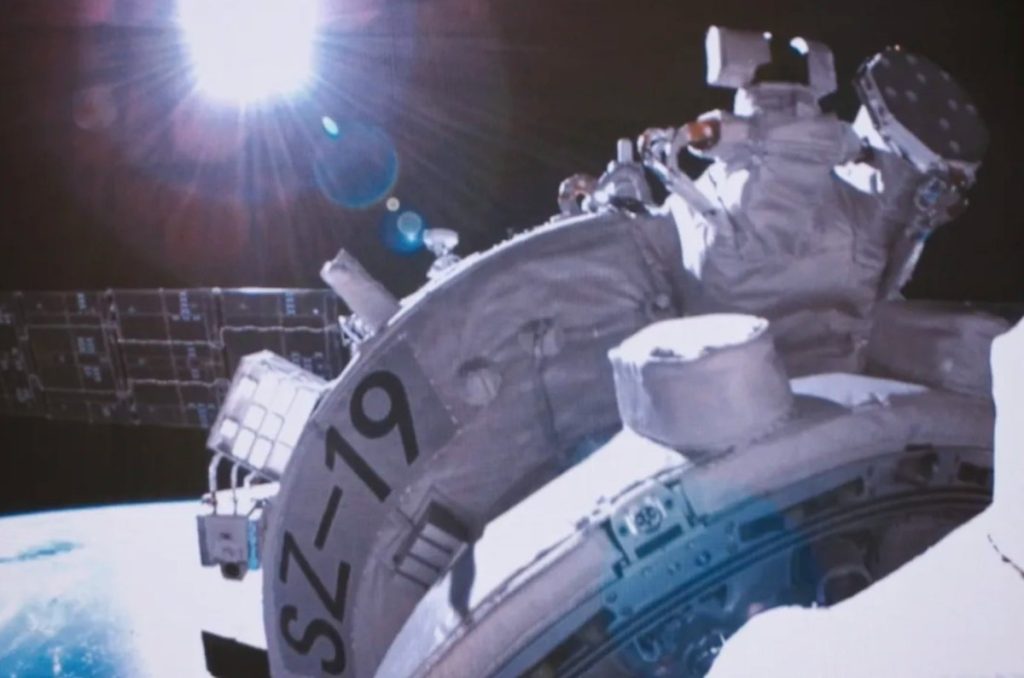HELSINKI — China is conducting its fifth crew rotation aboard the Tiangong space station after the arrival of three astronauts aboard Shenzhou-19.
Six astronauts are now aboard the space station following the docking of the Shenzhou-19 spacecraft at Tiangong at around 11:00 p.m. Eastern, Oct. 29. The astronauts were born variously in the 1970s, 1980s and 1990s.
Shenzhou-19 mission commander Cai Xuzhe and crewmates Song Lingdong, an air force pilot, and Wang Haoze, the country’s first woman space engineer, joined Shenzhou-18 astronauts Ye Guangfu, Li Cong and Li Guangsu aboard Tiangong early Oct. 30, after opening the hatch to the space station.
A Long March 2F rocket launched the Shenzhou-19 crew spacecraft from Jiuquan Satellite Launch Center Oct. 29, lifting off at 4:27 p.m. Eastern.
Cai and colleagues will be in orbit for around six months. Cai, 48, was a crew member for the 2022 Shenzhou-14 mission. Song and Wang, both 34 years old, are experiencing orbit for the first time.
The Shenzhou-18 crew, who arrived at Tiangong in April, will soon hand over control of Tiangong to the new arrivals and prepare for a return to Earth. Landing is scheduled for around 12:00 p.m. Eastern, Nov. 3, at the Dongfeng landing area near Jiuquan spaceport.
Shenzhou-19 is China’s 14th crewed spaceflight mission to date. The crew will conduct a number of extravehicular activities and will carry out 86 science experiments and projects, according to China’s human spaceflight agency, CMSEO. A number of these are related to life sciences.
“During the Shenzhou-19 mission, we will also send up a sub-magnetic facility with fruit flies. We know that in space, for instance, there’s no magnetic field on the moon, while Mars has a weak magnetic field,” Zhang Wei, a professor with the Technology and Engineering Center for Space Utilization under the Chinese Academy of Sciences, told China Central Television (CCTV).
“After sending the fruit flies up, we’ll observe what kind of biological reactions will occur under such conditions, including their development, growth, and any changes in their behavior. This will help us establish a theoretical understanding for our future exploration on the moon and Mars,” Zhang said.
A Tianzhou cargo spacecraft is expected to launch to Tiangong in November from Wenchang. It will carry supplies, fuel and experiments.
China approved its space station plan in 1992 and began building the three-module, T-shaped low Earth orbit outpost in 2021. It was completed in late 2022.
CMSEO is however preparing to expand Tiangong in the coming years. The first move will be sending a multi-functional expansion module with six docking ports to the orbital outpost. This expansion could allow for greater possibilities for international, tourist and commercial visits without disrupting core operations.
The agency also announced yesterday that two concepts for low-cost cargo transportation systems have been accepted for Tiangong. Four were under consideration at the detailed design phase. The move mirrors NASA’s Commercial Resupply Services (CRS) program for the International Space Station.
CMSEO selected the Qingzhou cargo spacecraft from the Innovation Academy for Microsatellites of the Chinese Academy of Sciences (IAMCAS) and the Haolong cargo space shuttle proposal from the Chengdu Aircraft Design Institute under the Aviation Industry Corporation (AVIC).
A timeline for launch of the missions was not explicitly stated. The launcher for the Qingzhou spacecraft—the CAS Space Lijian-2 kerosene-liquid oxygen rocket—is scheduled for a debut launch around September 2025.
Launch of Shenzhou-19 was China’s 52 orbital launch of 2024. The country had earlier outlined plans for around 100 launches across the year. Both state-owned CASC and commercial launch service providers appear to be significantly behind this projected launch rate.


